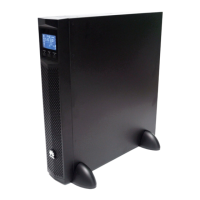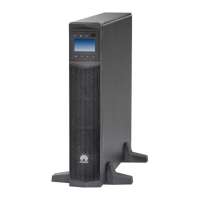17
3. If no alarm is displayed on the monitoring screen, continue with the subsequent operations. If
an alarm is displayed, clear the alarm.
4. Check that the bypass input is normal and the UPS has transferred to bypass mode by viewing
the system running status on the LCD.
5. Perform "startup operations" on each UPS: On the standby screen, hold down for about 5
seconds. Release the button when you hear a beep tone. The startup screen is displayed. If the
parallel system starts successfully, it enters the normal mode.
6. After the parallel system runs properly, close the general AC output circuit breaker (Q) for the
UPSs and start each load. To prevent triggering overload protection, start the loads with higher
power and then loads with lower power.
9
Shutting Down the Parallel System
1. Perform "shutdown operations" twice (one shutdown operation: On the standby screen, hold
down ESC for about 5 seconds. Release the button each time you hear a beep tone.) on a UPS
in the parallel system within 30 seconds. The UPS shuts down and enters the non-output state
(the mains, bypass, battery indicators are off). The other UPSs keep working.
2. Turn off the UPS AC input circuit breaker (K1 or K2) and AC output circuit breaker (Q1 or Q2).
3. Turn off the external battery circuit breakers (if there are), or disconnect battery power cables
(if there is no battery circuit breaker). The UPS exits the parallel system. After all indicators
turn off and fans stop, the UPS shuts down.
Perform "shutdown operations" on each UPS in the parallel system. The inverters shut down. If
the bypass voltage is within the configured range, the UPS transfers to bypass mode. If the
bypass voltage is beyond the configured range, the UPS has no output.
1. Shut down loads.
2. Perform "shutdown operations" on each UPS in the parallel system. The inverters shut down. If
the bypass voltage is within the configured range, the UPS transfers to bypass mode. If the
bypass voltage is beyond the configured range, the UPS has no output.
3. Turn off the AC input circuit breaker for each UPS (K1 or K2) and the general AC input circuit
breaker (K), and then turn off the AC output circuit breaker for each UPS (Q1 or Q2) and the
general AC output circuit breaker (Q).
4. Turn off the external battery circuit breaker for each UPS or the general battery circuit breaker
(when all UPSs share a battery string). If no external battery circuit breaker is configured,
disconnect battery power cables from each UPS. After all indicators turn off and fans stop, the
UPS shuts down and stops supplying power to loads.
Shutting Down a UPS in a Parallel System
9.1
Transferring a Parallel System to Bypass Mode
9.2
Powering Off a Parallel System
9.3
Perform "shutdown operations" twice on a UPS within 30 seconds. Otherwise, the UPS fails to
shut down.
